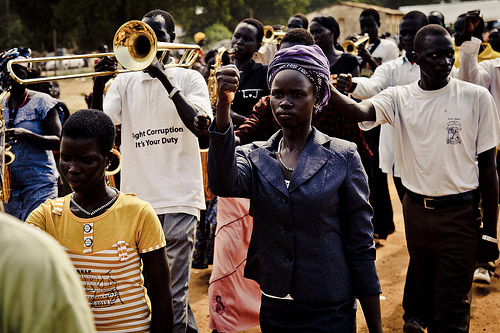
This post was originally published on National Security Network's Democracy Arsenal blog.
This Saturday, South Sudanese around the world will exuberantly celebrate the birth of the new country of South Sudan. Concerted international diplomacy, including the robust efforts of the Obama administration, helped pave the way for this moment, the culmination of a 2005 peace agreement brokered by the international community between the Sudanese government and what was then the southern rebel movement, the SPLM/A, to end two decades of war. But even as the arrival of South Sudan on the world stage is evidence of a diplomatic success, the insecurity that has proliferated in both the North and the South is a sharp reminder of the need for a comprehensive (US) approach to the multiple Sudanese conflicts.
In early June, violence broke out between Sudanese government forces and fighters in South Kordofan, a region that sits atop the North-South Sudan border. Reports trickling out from the ground describe government forces targeting civilians based on political sympathies and ethnic affiliations, searching house-to-house for opposition, and indiscriminately bombing large areas. “These acts could constitute war crimes or crimes against humanity,” said U.N. Ambassador Susan Rice in remarks at a Security Council briefing. Government authorities continue to deny access to international humanitarians, even coercing displaced populations to leave the refuge of U.N.-monitored areas. Untold numbers of civilians are dead, and at least 73,000 are displaced.
Violent management of dissent is not a new strategy for the regime in Khartoum, the same one that oversaw the devastation in Darfur, a region that today continues to be plagued by insecurity; just this year, the government has bombed Darfur 80 times. But unlike South Sudan, which experienced years of war with Khartoum to finally secede this weekend, the restive regions of South Kordofan and Darfur will still be part of Sudan come Saturday. The U.S. cannot overlook the chronic instability of Sudan which secession does not address.
Hostilities between North and South Sudan may not be over either. In May, the Sudanese government sent its troops to forcibly take over Abyei, a border area claimed by constituencies on both sides, even though negotiations over its status were ongoing. Peacekeepers are arriving to secure the area, but how the South Sudanese government will respond once it has acquired sovereignty, is unclear. The two governments have not agreed on how they will split oil revenues after separation. Most of the oil lies in the South, but the infrastructure for exporting the oil lies in the North, an interdependence that should demand cooperation and peace between the two states.
The host of unsettled issues means that the two parties may ramp up military aggressions, proxy violence, or manipulations of other sorts to strengthen their bargaining position at the negotiating table. In recent months, a blockade along the North-South border, stemming the usual traffic of goods, has exponentially raised the prices of key commodities in South Sudan; southern officials blame Khartoum. The African Union panel that is facilitating negotiations has shown almost no concrete progress for its year-long efforts to secure an agreement.
South Sudan itself faces myriad challenges, whether it be the dearth of basic infrastructure or capacity in the country, or the proliferation of militias within its borders. The way the government has managed diversity, dissent, and expectations within its population so far do not bode well for the future of the state. The U.S. can play an influential role in nudging the government toward inclusive politics and in supporting the professionalization of the South Sudanese army, an institution that has at times targeted, rather than protected, its own civilians in the name of security.
Going forward, the U.S. government must stay deeply engaged with efforts to stabilize both South Sudan and Sudan. In the South, the U.S. must wield the significant leverage it has to convince leaders to take the necessary steps toward peace. With Sudan, the relationship is much more hostile, and complicated by a deep distrust on the part of Khartoum. What is clear though, is that the graduated path of incentives leading to normalization offered by the U.S. last year was not enough to convince the regime away from military actions and the breaking of peace pacts.
With the independence of the South, its time for the U.S. to rethink its approach to Sudan. New pressure points need to be identified in coordination with international partners, whether they be the expansion of sanctions, the halting of international debt relief talks, or more robust efforts to reach international actors who hold Sudan’s purse strings. U.S. diplomatic efforts to resolve Sudan’s conflicts should shift from its current piecemeal approach—separate negotiations and peacekeeping missions for each individual crisis—to a holistic strategy that reflects the fact that behind the scenes, it’s the same regime pulling the same strings.
Photo: South Sudanese practice marching in preparation for independence celebrations (Tim Freccia/ Enough Project)

